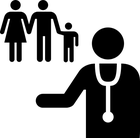Shanghai Street View: Good Medicine

My relationship with medical care in Shanghai has undergone a major transformation since I first arrived in the city to live more than 4 years ago. What began as feelings of fear at the mere thought of a doctor visit, mostly due to the crowds and long waits, has evolved into a much more sanguine relationship where I no longer dread such trips.
The turning point for me is quite clear, and came about 2 years ago when I discovered the mini-hospital at the university where I teach, which would probably be called a large clinic in the United States. Such clinics are quite common in the US, usually staffed with anywhere from a single physician to small groups of doctors, and are at the center of new Shanghai initiative to make getting medical care easier and more affordable for everyone in the city.
It’s common knowledge among the medical community that these smaller clinics are far cheaper to run than hospitals, since people usually visit them for minor problems and thus they require far less specialized equipment. And yet here in Shanghai, people seem to avoid such clinics, which suffer from a perception that they offer lower quality care than bigger hospitals.
That’s where the proposed new rules come in, aiming to move more routine cases away from hospitals and into neighborhood clinics. The rules are quite simple, banning people from hospital visits for treatment of colds, rashes and other minor illnesses.
The approach may sound a bit severe, but perhaps it’s necessary medicine to wean many of our city’s residents from their addiction to hospital care for everything. Even the smallest sneeze from me or other sign of a cold or fever will automatically draw quick sympathy from many of my Chinese friends, followed by their asking if I’ve been to the hospital to see a doctor yet.
All that brings me back to the original topic of my rapidly evolving relationship with medical care here in Shanghai. For the first 2 years after my arrival in the city, I was relatively healthy and avoided any doctor visits. But then 2 years ago I came down with pneumonia, even though I didn’t realize it at the time. But I felt so awful that I knew I needed to see a doctor to find out what was wrong.
Like many foreigners, I asked one of my local friends to accompany me and help to navigate the system. In the end it really wasn’t too bad, though we did have to wait in numerous lines first to register, then to see a specialist, get a blood test, chest x-ray, and finally to see the doctor again. That was when my pneumonia was finally diagnosed, and I was quite grateful for all the specialized care and equipment that could quickly determine my problem and give me appropriate medicine.
But then a year later a rash broke out on my arm, and I really didn’t want to go to the hospital again, even though I wanted some medicine. That was when I discovered my university’s clinic, where there were no lines, doctors who were quite capable of handling ordinary problems, and a tiny fee of 1 yuan that covered everything from registration, to doctor and medicine fees. Now I’m a regular visitor to that clinic, which is quite capable of handling all of my minor problems.
Such workplace-based clinics were actually the norm when I first came to China in the 1980s, and each state-owned work unit had its own facility to provide health care for its workers. People with complex problems had to visit bigger hospitals that could offer specialized treatment, though such visits were quite rare at that time. Then came the disbandment of most traditional work units in the 1990s, which saw the disappearance of those low-cost or free clinics and the rise of the big hospitals.
A few months ago I had a recurrence of another minor rash, and happened to mention my plans to visit the school clinic to some of my colleagues in the administrative offices. Several immediately offered alternatives, all of them big hospitals with top-notch dermatology clinics that would give me state-of-the-art care. I politely listened and then went to the clinic, where I wrapped up my entire visit in 15 minutes and got appropriate medicine that cleared up the problem, all for just 1 yuan.
Of course I realize that my university clinic isn’t open to everyone, and that the 1 yuan fee is one of my personal work benefits. But I’m also relatively confident that the growing number of neighborhood clinics opening up across are city are staffed with competent and caring professionals, and that many people could soon discover that pleasant reality if and when Shanghai approves its new rules to slim down the crowds at our hospitals.
